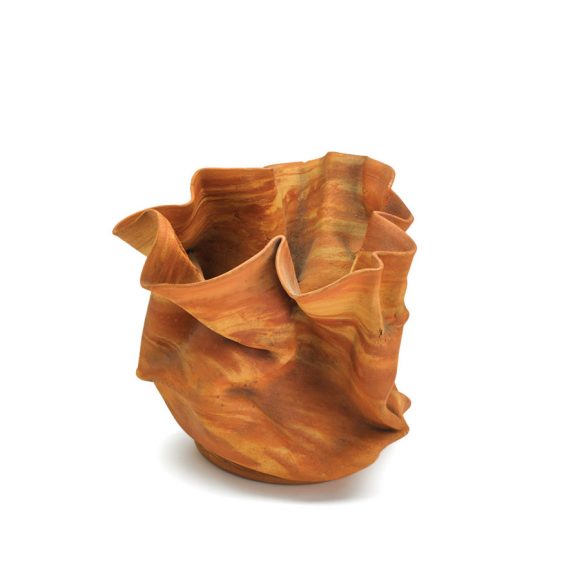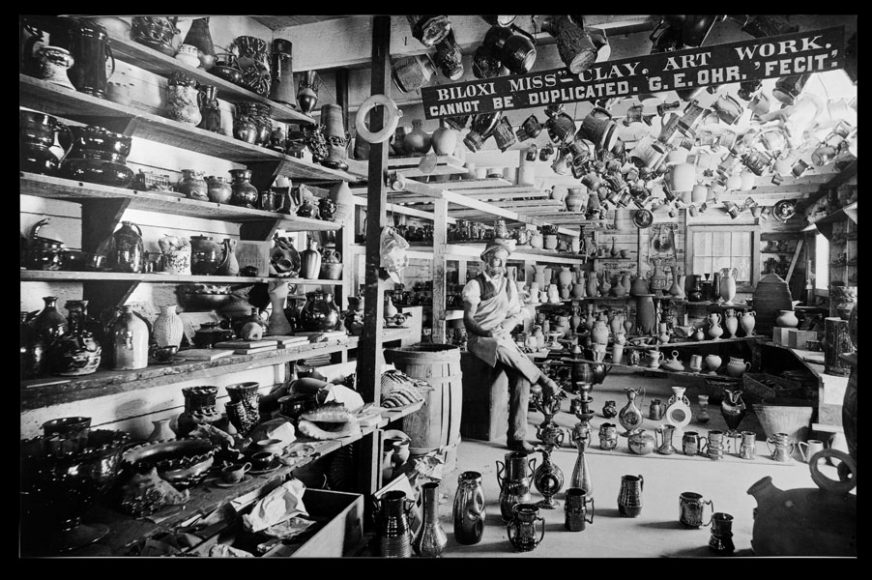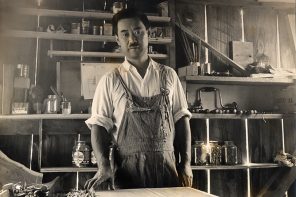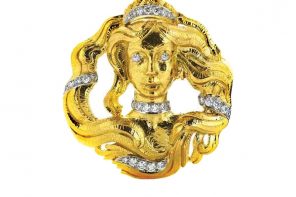The year 2018 was an exciting one for American art pottery aficionados. First off, Bob Ellison’s outstanding ceramic collection was permanently donated to The Metropolitan Museum of Art in Manhattan. And the accompanying catalog — “American Art Pottery: The Robert A. Ellison Jr. Collection” — was published.
Today, extraordinary works from Ellison’s 300 piece-strong gift are on display in The Met’s American Wing.
Secondly, among the most striking pieces are works by the Arts and Crafts ceramicist George Ohr, the self-styled “mad potter of Biloxi,” whose decree of “personality in every jar and jug” was no hollow boast. His eccentric and novel works, largely dismissed during his own lifetime, are today appreciated for the supreme skill involved in their fashioning and are seen as early examples of Modernism as well as precursors to contemporary ceramics.
Ohr (1857-1918) was born in Biloxi, Mississippi, to German immigrants. His father was a blacksmith; his mother ran a grocery store. Ohr tried his hand at more than a dozen trades before discovering his life’s work when a family friend invited him to join his pottery business in New Orleans. Ohr furthered his knowledge of ceramics with travels to potteries throughout the states in the 1880s. Returning to Biloxi, Ohr set up his own pottery business and began promoting his work farther afield, at regional fairs and expositions.
Unlike other potters, Ohr was involved in every part of the manufacturing process — from digging and preparing the clay to throwing, decorating and firing the pots. Ohr’s production included everyday wares and novelties such as inkwells in the shape of log cabins and cannons and puzzle mugs. Employing humorous and grandiose boasts, he was also the chief marketer of his work. His pottery became a local attraction for tourists who traveled to Biloxi for its temperate seaside climate. Today, these examples of Ohr’s pottery can be had on the auction market for a few hundred dollars.
It is Ohr’s more complex works, however, that garner so much attention today. These were chiefly his misshapen, asymmetrical vessels that were largely dismissed during his own lifetime. Ohr was a highly skilled potter, capable of throwing pots to the thinness of paper. Then he crushed, folded and twisted the walls of each vessel into a unique form. Ohr worked on a small scale so pieces that were more than 6 inches were considered tall. Works were often embellished with crimped edges or frilly handles that were too delicate to be functional. Some vessels were left unglazed or the clay body was embellished with colored slips to create a marbleized effect. Ohr’s glazes were an important component of his work. They featured contrasting colors and shocking hues. Some glazes were textured, creating blistered surfaces. The eccentric shapes and glazes of Ohr’s pieces were well out of the norm of pottery of the period.
By the turn of the century, Ohr’s presence at fairs and his self-aggrandizing marketing (he referred to himself as the “Greatest Art Potter on the Earth”) had raised his profile nationally, but did little to raise his sales. At Ohr’s last fair, the 1904 Louisiana Purchase Exposition, he won a silver medal. Yet he made not a single sale and had to raise funds to cover the return freight for his works. In 1909, Ohr closed the pottery studio and crated up thousands of his pieces.
His work remained largely unknown until the early 1970s when a New Jersey dealer, James Carpenter, negotiated with Ohr’s sons the sale of the collection and thus the works made their way into the marketplace. American art pottery expert David Rago remembers those early days: “Early on, like before 1975, you could have bought Ohr for $50 per piece, for a good one. Top prices were $500. Bisque work, the best bisque work, was unsold at $40 each. I was there when Jim unpacked about 200 pieces of bisque, 25 years ago, things remaining from the early days 20 years before that. A visit to Jim’s, back in the day, was pure magic.”
Today, Ohr’s work is critically acclaimed and widely collected and exhibited. In addition to The Met’s holdings, Ohr’s pieces can be viewed at the Ohr-O’Keefe Museum of Art in Biloxi.
At auction, Ohr’s best works vary in value from a few thousand dollars to the $50,000 to $100,000 range. Form, color and size all effect value. According to Rago, “Form is the most important and color is a serious factor. Reds are rare but multicolored flambés can be the best. Taller can be better, but some of Ohr’s larger pieces are clumsy and uncoordinated, and some of his smaller pieces are sublime. Whatever your price range, make sure to buy something distinctive, something that shows the artist’s personality and his particular quirks.”
Ohr always maintained a steadfast faith in his work, stating, “When I am gone, my work will be praised, honored and cherished. It will come.” And indeed it has.
Jennifer Pitman writes about the decorative arts, jewelry and fine art she encounters as Rago Arts and Auction’s senior account manager for Westchester and Connecticut. For more, contact jenny@ragoarts.com or 917-745-2730.








